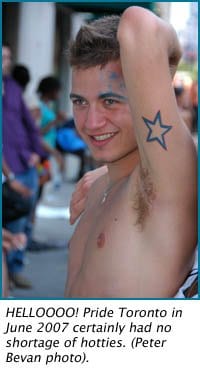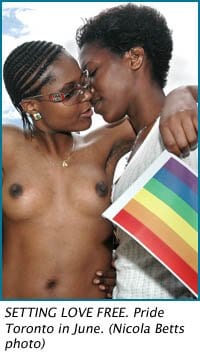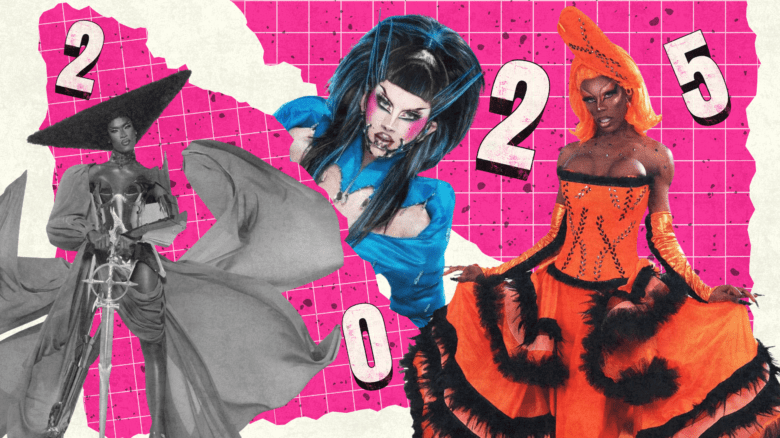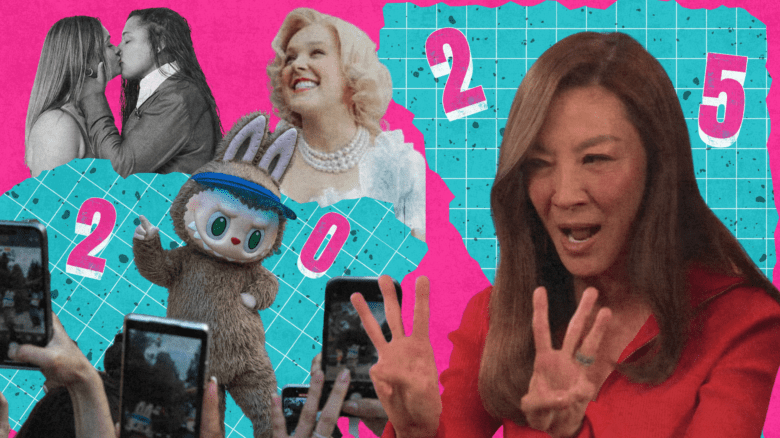There are basically three kinds of gay pride parades in the world.
There is the kind that can be found in the United States, throughout Western Europe and Canada, as well as in Sydney, São Paulo and Mexico City, among other places.
They vary in size and some are more fabulous than others. Pride in São Paulo, Brazil, this year attracted 3 million people, making it the largest gay pride parade ever — and that number came from the cops.
More than 200,000 people marched in Mexico City and there were more than 1 million at Europride, which relocates yearly and was in Madrid this year. Spain, of course, has become gay-fabulous under its current Socialist government. It is one of six countries in the world that have given gays access to full marriage. The others are Belgium, Canada, the Netherlands, South Africa and the U.S. (but only in Massachusetts).
Toronto is also known for having a particularly humongous pride parade, though the local gay press has suggested that the cops, for whatever reason, might be overestimating the attendance. Everywhere else on the planet, of course, it’s always the other way around.
Secondly, there are the kind of pride parades you find in places that aren’t particularly known as gay-magnet cities but also don’t seem to mind too much if the gays go marching — places like Tijuana, Panama City and, of course, certain smaller cities in the American South.
There are many drag queens in these parades and some number of closeted gay men lurking on the sidewalks watching. A higher percentage of marchers in these small parades are people who, for lack of a better way to put it, don’t have a choice about whether they’re openly gay or not.
Finally, there’s Eastern Europe, the former Communist bloc. For whatever combination of reasons, recent attempts to stage gay pride parades in these nations have met, rather consistently, with nasty outbursts of violence, mostly from religious folks. That’s also the case in Jerusalem, but not in Tel Aviv, for whatever reason.
Here, then, a look at some of this year’s gay-pride events around the planet that stood out from the pack.
Police stopped an “illegal” gay pride rally outside Moscow City Hall before it could start, arresting organizers as they arrived while anti-gay thugs severely beat Russian and foreign gays and lesbians who had gathered for the event. Mayor Yuri Luzhkov banned a planned parade, for a second year. He says gay pride parades are “satanic.”
“Police did nothing to arrest hooligans,” said Dutch European Parliament Member Sophie in ‘t Veld. “I saw a guy with a knife … and I thought: ‘That’s it. I’m out of here.'”
Several people were bloodied in the attack, including leading British gay activist Peter Tatchell and Right Said Fred singer Richard Fairbrass.
But chief pride organizer Nikolai Alekseev vows to forge onward, saying, “We will continue our fight for our rights no matter if it does not please Mr. Luzhkov.”
Last year’s attempt to march in Moscow was equally disastrous. Participants were violently attacked by neofascists, skinheads, Christians and riot police, and the pride organizers were taken into custody. A lawsuit over last year’s ban is pending before the European Court Of Human Rights.
Gay pride also didn’t go well in the Moldovan capital of Chisinau, for the third year in a row. City authorities banned all public pride events, even though the nation’s Supreme Court had declared last year’s ban illegal. The city says gay pride threatens public order, upsets Christians and promotes sexual propaganda. When gay activists tried to lay some flowers at a monument to victims of repression, police stopped them, so the activists dumped the flowers on the officers’ feet. Later, a group of activists went down to City Hall and stood there for 15 minutes with their mouths taped shut with rainbow stickers.
Pride organizer Boris Balanetkii called that little action “the first small victory in the fight of the LGBT community for the freedom of assembly in Moldova.”
Warsaw is another place where gay pride has been banned and attacked in recent years, but, this year, armed with a ruling from the European Court Of Human Rights, 20,000 people marched through downtown relatively unscathed. They were, however, protected by a huge number of cops.
But maybe not as many cops as in Bucharest, Romania, where it took 800 officers to protect 500 marchers. The cops tear-gassed hundreds of anti-gay hooligans who bombed marchers with rocks, firecrackers, garbage, eggs and tomatoes. More than 100 of the miscreants were arrested.
But that was nothing compared to Jerusalem, where a whopping 8,000 cops protected 3,000 marchers. The truncated parade travelled only about 500 meters. All three religions that consider Jerusalem “holy” get totally bent out of shape over marching homosexuals. March opponents rioted for several days prior to the parade and 130 of them were carted off to jail.
I could go on with this cavalcade of pride-o-phobia — because Moscow, Chisinau, Bucharest and Jerusalem are just examples. I mean, I didn’t even mention Riga, Latvia, where ill-behaved Christians bombed prideful gays and lesbians with bags of shit last year. But I’m getting depressed writing this. It’s time for happy news.
Happy news like São Paulo, Brazil, where 3 million people turned out for the 11th pride parade this year. That’s equal to the entire population of San Diego County, and it was a world record. Marchers included the mayor, the governor and the federal sports and tourism ministers. And get this: 70 other Brazilian cities also have gay pride celebrations, according to the BBC.
Happy news like Europride, funded with 100,000 euros from the city of Madrid, where well over 1 million folks marched. And that’s not to suggest that all the homos in Europe came to Madrid for the day — because 700,000 people took part in Paris’ pride march the same day, including openly gay Mayor Bertrand Delanoë. (The mayor of Berlin, by the way, is openly gay, too — Klaus Wowereit.) And London also held its pride the same day as Europride. Fab gay-friendly Mayor Ken Livingstone showed up with his two young children — for both the parade and the party afterward.
Mexico City’s poorly organized but nonetheless faboo parade, also the same day as Europride, took hours upon hours to wind its way to the Zócalo, the very epicenter of the Mexican Republic. San Diegan Fergal O’Doherty, who was learning Spanish in Cuernavaca this summer, told me that the Zona Rosa, the gay district, was still so crowded at 2 a.m. that he was, much to his dismay, unable to enter even a single gay bar.
Happy news like — you gotta love it — Cochabamba, Bolivia, where prideful gays and lesbians staged a fair in the central square and then marched for the first time two days later. A local daily newspaper said thousands of Cochabambinos (really, that’s what the residents are called) danced in the streets in “an overflow of glamour, joy, luxury, colour and respect.”
I’m feeling better already.
Hundreds marched in San Salvador, El Salvador. Gays rallied in a park in Santo Domingo, Dominican Republic. Three hundred attended the Festival of Art and Diversity in Guayaquil, Ecuador.
Pride organizers in Panama City awarded their first 10 Pink Egg prizes to individuals who “have committed the most acts of discrimination against the GLBT population of Panama.” Five thousand people gathered in Santiago, Chile, for seven hours of dancing, music and drag shows. Ten thousand people marched in Bogotá, Colombia, including a group of prideful skinheads. Mayor Luis Eduardo Garzón showed up and let the gay community feel his love.
A hundred thousand marched in Rome, led by transgender Member of Parliament Vladimir Luxuria. Then they rallied in the square where the pope has his office in his capacity as bishop of Rome. Fifteen thousand people marched in Tel Aviv. Police kept the wingnuts holding “God hates debauchery” signs at bay.
In Riga, after the shit incident last year (which took place outside a gay church service after the city banned a parade), there was an actual march this year. Inside a fenced-in park. It took a court order to make even that happen. Hundreds upon hundreds of cops protected the 500 marchers from jeering anti-gay hoodlums who threw firecrackers, a paint bomb and… an ice-cream cone over the fence. All in all, not bad, compared to last year!
Marchers included Sweden’s migration affairs minister, six Swedish members of Parliament, a Danish MP, a German MP, three members of the European Parliament, scores of Swedish activists, a large multinational contingent from Amnesty International, and gay cops from Britain and Sweden. Europe was not amused by last year’s fiasco.
Latvia, by the way, stands alone as the only nation in the world with an organization specifically created to disrupt and prevent gay pride parades. Members of “No Pride” wear T-shirts showing two male stick figures engaging in rear-entry anal sex with the international circle-and-slash “no” symbol superimposed on top of them.
Charming.
Pride was cancelled in neighbouring Lithuania this year. It was the first attempt to do pride in Vilnius. Organizers hoped to display a 30-meter rainbow flag in the central square, accompanied by the European Union’s traveling “anti-discrimination truck.” But officials banned the truck from entering the city — the first time the truck has been discriminated against — and refused to issue a permit for the rally, saying it was likely to provoke anti-gay riots. Probably true. But isn’t that what cops are for?
The city also banned gay pride ads from appearing on public-transport vehicles. The hopelessly subversive ads stated: “A lesbian can work at school,” “A gay man can serve in the police force” and “Homosexual employees have a right to be open and safe.”
The gall.
The ads actually got onto buses in the Lithuanian city of Kaunas, but then the bus drivers refused to drive the buses, for fear of being mocked by their friends, so the ads were removed.
In the new European Court Of Human Rights decision mentioned above, which involved Warsaw’s 2005 ban on a gay pride parade, the court ruled that Poland breached the European Convention On Human Rights’ guarantee of freedom of association and assembly, its prohibition on discrimination, and its guarantee of a right to an effective remedy.
That should function as a precedent that ought to let gays march freely in the 47 nations that are members of the Council Of Europe. The Euro court is, after all, the court of final appeal for citizens of the 47 nations, which are: Albania, Andorra, Armenia, Austria, Azerbaijan, Belgium, Bosnia and Herzegovina, Bulgaria, Croatia, Cyprus, Czech Republic, Denmark, Estonia, Finland, France, Georgia, Germany, Greece, Hungary, Iceland, Ireland, Italy, Latvia, Liechtenstein, Lithuania, Luxembourg, Malta, Moldova, Monaco, Montenegro, the Netherlands, Norway, Poland, Portugal, Romania, Russia, San Marino, Serbia, Slovakia, Slovenia, Spain, Sweden, Switzerland, “the former Yugoslav Republic of Macedonia” (that’s its name; long story), Turkey, Ukraine and the United Kingdom. Belarus has applied for membership but its previous “special guest status has been suspended due to its lack of respect for human rights and democratic principles,” the COE Web site says.
At least seven of these nations have impeded pride to a greater or lesser extent in recent years, while GLBT people in several of the nations have yet to dare to attempt to march, but you can be sure they’re thinking about it.
In a press summary of its ruling, the Euro court said, “The positive obligation of a State to secure genuine and effective respect for freedom of association and assembly was of particular importance to those with unpopular views or belonging to minorities, because they were more vulnerable to victimization.”
So, as you perhaps yawn your way through a Pride parade this year — muttering “been there, done that” (and I’m guilty of this) — at least stop and think for a moment about how utterly amazing our parade would be to gays and lesbians from Albania, Nigeria or China. Saudi Arabia, Egypt or India. Or even Moscow. Not to mention North Korea, which claims to have zero AIDS cases, or Iran, which hangs homosexuals.
For most gay people on the planet the simple act of thousands of people hitting the streets to celebrate queerness would Completely Blow Their Minds.


 Why you can trust Xtra
Why you can trust Xtra


